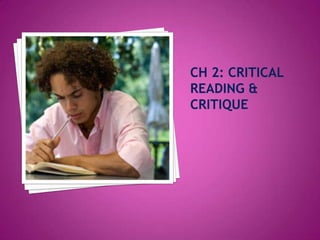Ch 2 critique
•Télécharger en tant que PPTX, PDF•
2 j'aime•6,861 vues
Signaler
Partager
Signaler
Partager

Recommandé
Recommandé
Contenu connexe
Tendances
Tendances (20)
Social Awareness Proposal Preparation (Writing Exercise from 4/21/16)

Social Awareness Proposal Preparation (Writing Exercise from 4/21/16)
Mercu learning ctr (socialstudies) seminar_18_jul2012_slideshare

Mercu learning ctr (socialstudies) seminar_18_jul2012_slideshare
Service Learning Proposal Preparation (Writing Exercise from 4/21/16)

Service Learning Proposal Preparation (Writing Exercise from 4/21/16)
Problem-Solution Proposal Preparation (Writing Exercise from 4/21/16)

Problem-Solution Proposal Preparation (Writing Exercise from 4/21/16)
Similaire à Ch 2 critique
Similaire à Ch 2 critique (20)
Notes for Claim Writing Success1. Comments on Titles Sample #.docx

Notes for Claim Writing Success1. Comments on Titles Sample #.docx
COM 510 Final Project One Research Paper Guidelines and Rub.docx

COM 510 Final Project One Research Paper Guidelines and Rub.docx
ENG 123 Assignment Two, Milestone One Guidelines and Rubric Draft O.docx

ENG 123 Assignment Two, Milestone One Guidelines and Rubric Draft O.docx
Plus de Shelly Yarbrough
Plus de Shelly Yarbrough (20)
Dernier
Mehran University Newsletter is a Quarterly Publication from Public Relations OfficeMehran University Newsletter Vol-X, Issue-I, 2024

Mehran University Newsletter Vol-X, Issue-I, 2024Mehran University of Engineering & Technology, Jamshoro
Dernier (20)
Basic Civil Engineering first year Notes- Chapter 4 Building.pptx

Basic Civil Engineering first year Notes- Chapter 4 Building.pptx
Seal of Good Local Governance (SGLG) 2024Final.pptx

Seal of Good Local Governance (SGLG) 2024Final.pptx
ICT Role in 21st Century Education & its Challenges.pptx

ICT Role in 21st Century Education & its Challenges.pptx
Python Notes for mca i year students osmania university.docx

Python Notes for mca i year students osmania university.docx
This PowerPoint helps students to consider the concept of infinity.

This PowerPoint helps students to consider the concept of infinity.
Z Score,T Score, Percential Rank and Box Plot Graph

Z Score,T Score, Percential Rank and Box Plot Graph
Ch 2 critique
- 1. Ch 2: Critical Reading & Critique
- 2. Evaluating Persuasive Writing Are the terms clearly defined, when necessary? Is the information fair & recent? Does the information represent what it is intended to represent?
- 3. Are there logical fallacies? Emotionally loaded terms: words that influence the reader (ex. horrible, bright) Ad Hominem argument: attacking the person (ex. sexist pig, idiot) Faulty cause & effect: the first event does not necessarily cause the second
- 4. Either/or reasoning: presenting only 2 options when, in reality, more exist Hasty generalization: drawing a conclusion without enough evidence False analogy: comparing two things that are not really comparable
- 5. Circular Reasoning: assuming your opinion to be fact; restating the opinion as a “reason” Non Sequitur: drawing a conclusion that is not necessarily true Oversimplification: offering an easy solution to a complicated problem
- 6. Step 1: Identify and evaluate the author’s purpose(reason for writing) a) Writing to INFORM... Is information accurate? Significant? Fair? b) Writing to PERSUADE... Are terms clearly defined? Is information used fairly? Are there logical fallacies?
- 7. Step 2: Identify the article’s strengths & weaknesses Is the writing clear or confusing & repetitive? Is the article well-organized or disorganized? Are the assumptions correct or incorrect? Are the examples solid or weak? Is the support useful or not? Is the article free of fallacies or not? Does the writer state his/her point well or weakly? In the end, do you agree with the point this article makes? Why or why not?
- 8. Step 3: Write the outline I. Intro—title, when & where published, author & credentials, author’s purpose and intended audience II. Summarize the article III. Body Paragraph 1—strengths (Where does the writer succeed in his/her purpose?) IV. Body Paragraph 2—weaknesses (Where does the writer fail in his/her purpose?) V. Body Paragraph 3—personal response (Do you agree with author’s point? Why or why not?) VI. Conclusion—restate author’s points and summarize your opinions
